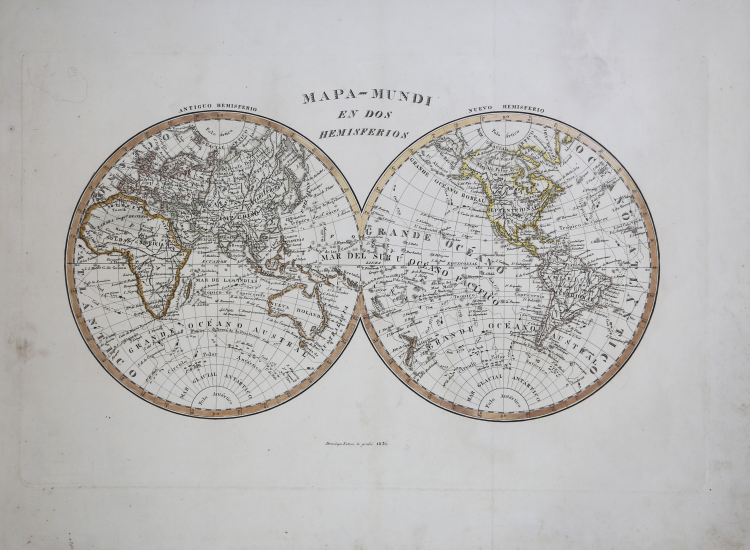



| Reference: | S46181 |
| Author | Domingo Estruch y Jordán |
| Year: | 1831 |
| Zone: | The World |
| Measures: | 480 x 305 mm |


| Reference: | S46181 |
| Author | Domingo Estruch y Jordán |
| Year: | 1831 |
| Zone: | The World |
| Measures: | 480 x 305 mm |
Rare double hemisphere map of the world engraved by Domingo Estruch y Jordán and printed in Barcelona in 1831.
Domingo Estruch y Jordán (Muro de Alcoy, 1786-Madrid, 1851) was a Spanish engraver. Born in Muro, in the province of Alicante, he moved at a very young age to Valencia, where his uncle Francisco Jordán lived, who taught him drawing and the art of engraving. The French invasion of 1808 forced him to move to Majorca and then to Havana, from where he returned to Barcelona, where he settled and where his sons, also engravers, were born: Juan, employed by the Hydrography Directorate and specializing in engraving maps, and Alberto, a revenue engraver at the Stamp Factory, from where he moved on to the Royal Mint in Manila. The works in which he excelled most were the engravings of San José, San Bruno, San Juan Bautista and the equestrian portrait of Don Mariano Álvarez de Castro, governor of Gerona. He also distinguished himself in the engraving of geographical and topographical maps, including the History of Ancient Greece and the great Map of the Island of Cuba, for whose work the Cortes of the Kingdom made honorable mention of its author when they saw the said map, and admitted him in their bosom, as an individual of merit and correspondent, to several academies and artistic guilds. Called to Madrid to execute other important works, he died in that city in July 1851. He was an academician of merit of the San Carlos Academy of Fine Arts in Valencia and a correspondent of the Real Sociedad de Fomento of Havana.
Etching with contemporary outline colour, good condition.
Domingo Estruch y Jordán (Muro de Alcoy, 1786-Madrid, 1851)
|
Domingo Estruch y Jordán was a Spanish engraver. Born in Muro, in the province of Alicante, he moved at a very young age to Valencia, where his uncle Francisco Jordán lived, who taught him drawing and the art of engraving. The French invasion of 1808 forced him to move to Majorca and then to Havana, from where he returned to Barcelona, where he settled and where his sons, also engravers, were born: Juan, employed by the Hydrography Directorate and specializing in engraving maps, and Alberto, a revenue engraver at the Stamp Factory, from where he moved on to the Royal Mint in Manila. The works in which he excelled most were the engravings of San José, San Bruno, San Juan Bautista and the equestrian portrait of Don Mariano Álvarez de Castro, governor of Gerona. He also distinguished himself in the engraving of geographical and topographical maps, including the History of Ancient Greece and the great Map of the Island of Cuba, for whose work the Cortes of the Kingdom made honorable mention of its author when they saw the said map, and admitted him in their bosom, as an individual of merit and correspondent, to several academies and artistic guilds. Called to Madrid to execute other important works, he died in that city in July 1851. He was an academician of merit of the San Carlos Academy of Fine Arts in Valencia and a correspondent of the Real Sociedad de Fomento of Havana.
|
Domingo Estruch y Jordán (Muro de Alcoy, 1786-Madrid, 1851)
|
Domingo Estruch y Jordán was a Spanish engraver. Born in Muro, in the province of Alicante, he moved at a very young age to Valencia, where his uncle Francisco Jordán lived, who taught him drawing and the art of engraving. The French invasion of 1808 forced him to move to Majorca and then to Havana, from where he returned to Barcelona, where he settled and where his sons, also engravers, were born: Juan, employed by the Hydrography Directorate and specializing in engraving maps, and Alberto, a revenue engraver at the Stamp Factory, from where he moved on to the Royal Mint in Manila. The works in which he excelled most were the engravings of San José, San Bruno, San Juan Bautista and the equestrian portrait of Don Mariano Álvarez de Castro, governor of Gerona. He also distinguished himself in the engraving of geographical and topographical maps, including the History of Ancient Greece and the great Map of the Island of Cuba, for whose work the Cortes of the Kingdom made honorable mention of its author when they saw the said map, and admitted him in their bosom, as an individual of merit and correspondent, to several academies and artistic guilds. Called to Madrid to execute other important works, he died in that city in July 1851. He was an academician of merit of the San Carlos Academy of Fine Arts in Valencia and a correspondent of the Real Sociedad de Fomento of Havana.
|